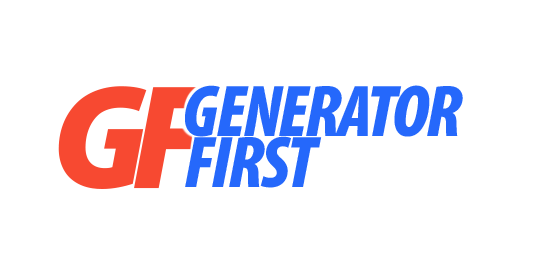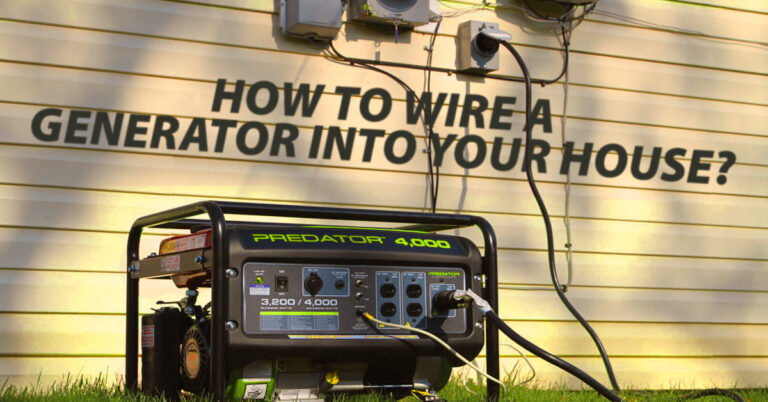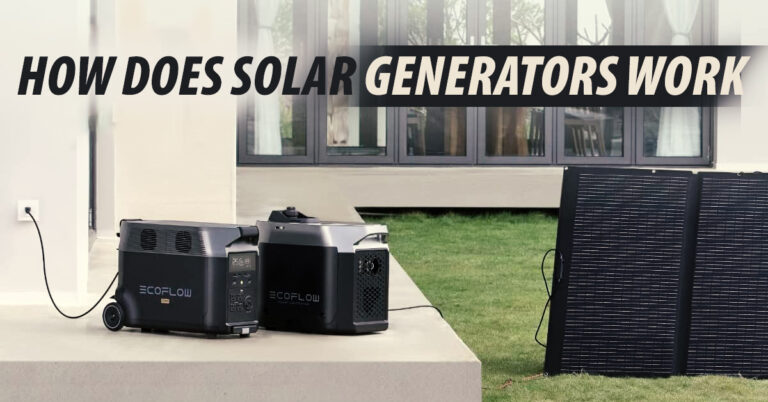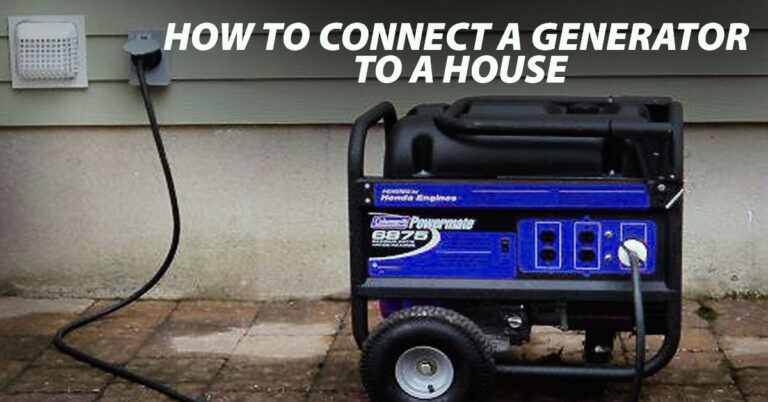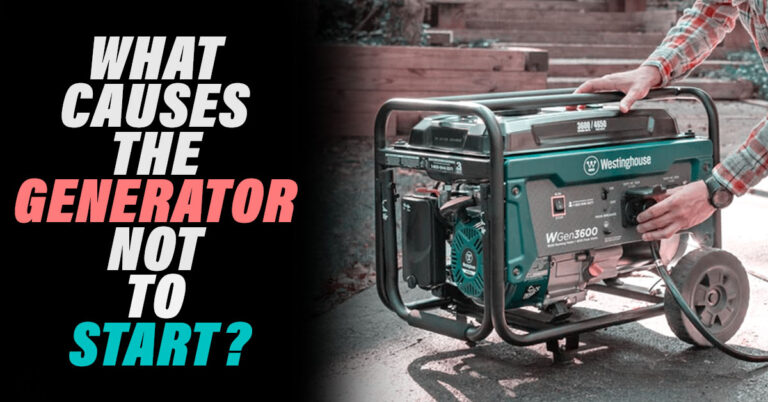How to Connect Generator To House Without Transfer Switch?
Unexpected power outages can occur, so having a secondary power source is important. A transfer switch is the safest and most practical method to connect a generator to your home, but this may not always be an option. Fortunately, you can link your generator immediately to the electrical system in your house in several ways. A heavy-duty extension cord, wiring through a circuit breaker, wiring directly to the main electrical panel, wiring through a relay, and connecting to the home using a power inverter are all covered in depth in this article. We will also discuss the safety measures you should take when connecting your generator to the electrical system in your house. Let’s get started by attaching a generator to your home without a transfer switch.
How to Connect Generator To House Without Transfer Switch?
Methods for connecting a generator to a home without a Transfer Switch:
Wiring Through A Breaker Box
Wiring a generator through a breaker box can be practical and secure when there is a power outage. This technique entails attaching your generator to your home’s electrical panel using a specialty power inlet box and a breaker interlock kit.
The following Is How To Connect A Generator To A Breaker Box
- Determine The Amperage Of Your Breaker Box: You must ascertain the amperage before connecting your generator to it. This will enable you to choose the proper dimensions for the breaker interlock kit and power inlet box.
- Install A Power Inlet Box: A weatherproof box installed outside your house is a power inlet box. It offers a simple and secure method to connect your generator to the electrical system in your house. The power inlet box must be installed close to your electrical panel, and a conduit must be extended from the box to the panel.
- Install A Breaker Interlock Kit: A breaker interlock kit is a mechanism that stops your generator from operating simultaneously with your primary power source. Thanks to this device, which is installed inside your electrical panel, you can alternate between using the generator and your primary power source. A new breaker that is installed in your panel as well as a sliding plate that locks the primary breaker in the off position while the generator is running, are both included in the kit.
- Connect The Generator To The Power Inlet Box: Once the breaker interlock kit and power inlet box have been installed, you can use a heavy-duty generator cord to link your generator to the power inlet box. Ensure the cable is the appropriate size and length for your generator and the distance from the power inlet box.
- Turn off The Main Breaker: Turn off the main breaker in your electrical circuit before starting your generator. This will stop power from the utility company from reaching your house while the generator is running.
- Start The Generator: Turn it on and give it a few minutes to power up. When everything is prepared, switch the new breaker the interlock kit has put in the on position.
- Power Your Home: Your generator should now be supplying electricity to your home’s electrical system. To prevent overloading your generator, keep an eye on the load.
Safety Measures To Take Into Consideration When Connecting Through A Breaker Box:
- Always adhere to the manufacturer’s directions when assembling the power inlet box and breaker interlock kit.
- Always switch off the main breaker before turning on your generator.
- To avoid a buildup of carbon monoxide, keep the power inlet box and generator at least 10 feet away from your house.
- When dealing with electricity, exercise caution and always turn off the power before connecting any electrical devices. Hire a certified electrician if you don’t feel secure handling electricity.
Wiring Directly To The Main Electrical Panel
A generator can be connected to a home without a transfer switch by being wired straight to the main electrical panel. It entails immediately attaching the generator’s output to the main electrical panel, dispersing power to the house’s various circuits.
The Procedures To Connect A Generator Straight To The Main Electrical Panel:
- Turn Off The Main Circuit Breaker: Do this before connecting the generator to the main electrical panel. Therefore, the panel is completely unplugged and safe to work on.
- Install A Generator Interlock Kit: This safety measure stops the generator from returning power to the utility lines. Observe the manufacturer’s directions when installing the interlock kit on the main electrical panel.
- Mount A Generator Inlet Box: Install a generator inlet receptacle on the house’s exterior, close to where the generator will be placed. The male plug on this box should be able to plug into the electrical outlet on the generator.
- Run A Power Cord: Connect a sturdy power line from the generator to the inlet box for the generator. Ensure the cord is rated for the generator’s power and the distance between it and the inlet box.
- Connect The Power Cord To The Generator Inlet Box: Connect the power cord to the generator’s inlet box. The female receptacle on the power cord’s female end should match the male connector on the inlet box.
- Connect The Generator Inlet Box To The Interlock Kit: Connect a wire from the generator inlet box to the interlock kit on the main electrical panel. The cable can be plugged into the interlock kit’s two slots, one for the utility electricity and one for the generator.
- Connect The Cable To The Breaker: The wire from the generator inlet box should be connected to a specific breaker on the main electrical panel. The output of the generator should be able to manage this breaker.
- Turn On The Main Circuit Breaker: After all, connections have been made, switch on both the main circuit breaker and the specific breaker for the generator. The generator should now be supplying electricity to the house.
Safety Measures While Wiring Directly To The Main Electrical Panel
- Before performing any work on the main electrical panel, always turn off the primary circuit breaker.
- Verify that the generator’s specified breaker is capable of handling its output.
- To stop back feeding into the utility lines, use a generator interlock device.
Wiring Through A Relay
Relay wiring is a secure and reliable method to connect your generator to the electrical system in your house. A relay is a switch that only permits the passage of electrical current when it receives a signal from another source, like a generator. Back feeding is when electricity from the generator flows back into the utility lines, possibly endangering utility employees and harming equipment. Back feeding can be prevented by wiring your generator through a relay.
An Explanation Of How To Wire A Generator Through Relay
- Select A Relay: You must choose a relay that is compatible with both the electrical system in your house and the output of your generator. Find a relay designed for the voltage and amperage your generator can handle.
- Installing The Relay: Install the relay in a protected and easily accessible area, like a junction box or breaker panel.
- Wire the relay: Relay wiring involves attaching the relay’s power supply cables to an independent power source, such as a generator-specific circuit, that is not connected to your home’s electrical system. The circuit breaker that regulates the utility power supply to your house should then be connected to the relay’s switching wires.
- Connect The Generator: Use a sturdy extension cord or another suitable connection to connect your generator to the relay. Only when the switching wires activate the relay will it permit generator electricity to pass through it?
- Test The System: Once everything is connected, test the system to ensure it functions correctly. Start your generator and cut off the main power to your house. The electrical system in your house should be able to receive power from the generator if the relay is operating properly.
Protection Measures
Safety must always be considered when connecting a relay. Following are some protection guidelines:
- Ensure all wiring is securely connected and the relay is mounted in a secure but easily accessible location.
- Connect your generator to the relay using sturdy extension cords certified for the necessary amperage.
Connecting To The House Through A Power Inverter
A power inverter can link a generator to your home if you don’t have a transfer switch. A power inverter transforms the DC power from a battery or generator into AC power, which can then be used to power home equipment.
Here’s How To Use An Electricity Inverter To Connect A Generator To Your Home
- Choose The Right Power Inverter: The power inverter you select should be capable of handling the wattage of the appliances you intend to power. Choose an inverter that can manage at least that much wattage after adding up all the appliances you want to power at once. For instance, you’ll need an inverter that can manage at least 900 watts if you want to power a refrigerator (600 watts), a TV (100 watts), and some lights (200 watts).
- Connect The Inverter To The Generator: The positive and negative wires from the inverter should be connected to the generator’s positive and negative terminals. Ensure the cables are well insulated and firmly connected to avoid any electrical shorts.
- Connecting The Inverter To Your Home: Use a sturdy extension cable to connect the inverter’s AC output to a regular electrical outlet. To power your tools, plug them into this outlet. Use a strong extension cord that is regulated for the amount of wattage you require.
- Start The Generator: The generator should be started and left running. The inverter will transform the generator’s DC power into AC electricity for your appliances.
Safety Measures While Connecting To The House Through A Power Inverter
- Be Cautious When Using Cords: Ensure the extension cord is in excellent condition and rated for the required wattage. Cords should not be near water or other dangers.
- Avoid overloading the inverter by ensuring it can support the wattage of the items you intend to power. You risk harming the inverter or causing a fire if you attempt to power more appliances than the inverter can.
- Never Use A Generator Indoors Or Enclose It: keep it outside. The generator’s carbon monoxide can be fatal. Use a lengthy extension cord to link the generator to the inverter outside, away from doors and windows.
- Use a GFCI outlet: To avoid electrical shocks, use a GFCI outlet when connecting the inverter to an outlet.
Use A Heavy-Duty Extension Cord
When a transfer switch is unavailable, connecting a generator to a home with a heavy-duty extension cord can be successful. To attach a generator to a home, use the following instructions on choosing and using a heavy-duty extension cord:
Making a Heavy-Duty Extension Cable Selection
Keep the following things in mind when choosing an extension cord:
- Length: Long enough to reach from the generator to the home but not so long that it causes a voltage drop or overheats.
- Gauge: Select a cable whose gauge corresponds to the generator’s amperage output. When the gauge number is smaller, the cord is thicker and can handle more current.
- Type: Opt for an extension cord with strong, weather-resistant insulation that is particularly made for outdoor use.
Using A Heavy-Duty Extension Cord
To use an extension cord safely, follow these guidelines:
- Before connecting the other end to the home, plug the extension cord into the generator.
- Keep the cord out of wet areas like snow, precipitation, or slush.
- Avoid piling too many appliances or devices on the cable because doing so could make it overheat and pose a fire risk.
- Regularly inspect the cord for wear, fraying, or other damage; replace it if required.
- Run the cable around obstructions like doors, windows, and other openings to avoid damaging it.
safety Measures
- The following safety measures must be remembered when using a heavy-duty extension cord.
- Always turn off the generator and unplug it before connecting or disconnecting an extension cable.
- Ensure that the generator is correctly grounded to avoid electric shock or electrocution.
- Avoid touching any electrical appliances or devices, including the extension cable, with wet hands or while standing in water.
- Frayed or damaged cables should be avoided because they pose a risk of fire, overheating, or electrical shock.
- Keep the extension cable and generator away from anything that could catch fire, like gas or propane tanks.
FAQs
-
Can I connect my generator without a transfer switch to the electrical panel in my home?
A transfer switch is not required, but connecting your generator straight to your home’s electrical panel is possible. This procedure can be harmful and is forbidden in many places. Connecting your generator to your house using a transfer switch is advised.
-
Can I connect my generator to my house using any extension cord?
A heavy-duty extension cord designated for your generator’s wattage and voltage should be used instead. Using a subpar extension cord can result in device damage, overheating, and even fires.
-
Is wiring my generator through a breaker panel secure?
A safe and effective way to connect your generator to your house is by wiring it through a breaker box. To ensure your installation complies with local codes and standards, you should have it inspected by a licensed electrician and take all necessary safety measures.
-
Do I need a power inverter to link my generator to my home?
A power inverter can be a helpful tool for converting DC power from your generator to AC power for your home, but it is not required to connect your generator to your home. It is crucial to select an inverter compatible with your generator and electrical system and use it while adhering to the necessary safety measures.
-
Can I link my generator to my house using a relay to prevent back feeding?
A relay can be a useful tool for preventing back feeding and ensuring the safe functioning of your generator. However, having a certified electrician install the switch and using your generator with the correct safety measures is crucial.
Generator wiring connection diagram to the main distribution board using the manual changeover switch

Conclusion
A practical answer for power outages may be to link a generator to a home without a transfer switch. However, it’s crucial to remember that when working with energy, safety should always come first. Each method mentioned, including using a heavy-duty extension cable, wiring through a main electrical panel or breaker box, using a relay, or connecting through a power inverter, has pros and cons. Understanding the precise specifications and constraints of your generator and electrical system is essential, as is adhering to all safety precautions and instructions the maker recommends. Connecting a generator to a home without a transfer switch can offer temporary backup power for necessary home appliances and devices with the right preparation, tools, and expertise.
